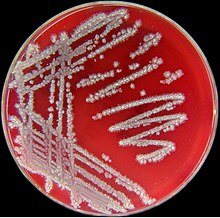| Bacillus licheniformis | |
|---|---|

| |
| Bacillus licheniformis colonies on a blood agar plate. | |
| Scientific classification | |
| Domain: | Bacteria |
| Phylum: | Bacillota |
| Class: | Bacilli |
| Order: | Bacillales |
| Family: | Bacillaceae |
| Genus: | Bacillus |
| Species: | B. licheniformis
|
| Binomial name | |
| Bacillus licheniformis (Weigmann 1898) Chester 1901[1]
| |
Bacillus licheniformis is a bacterium commonly found in the soil. It is found on bird feathers, especially chest and back plumage, and most often in ground-dwelling birds (like sparrows) and aquatic species (like ducks).
It is a gram-positive, mesophilic bacterium. Its optimal growth temperature is around 50 °C, though it can survive at much higher temperatures. The optimal temperature for enzyme secretion is 37 °C. It can exist in a dormant spore form to resist harsh environments, or in a vegetative state when conditions are good.
High capacity of secretion of the alkaline serine protease has made B. licheniformis one of the most important bacteria in industrial enzyme production.[2] Subtilisin Carlsberg (P00780) secreted by B. licheniformis is used as a detergent protease. It is sold under the name Alcalase by Novozymes.[3] A small antisense RNA against Subtilisin Carlsberg named BLi_r0872 was discovered in an RNA-seq based study. It may have a putative impact on protease production and serve as target for strain improvement.[4]
Scientists are currently exploring its ability to degrade feathers for agricultural purposes. Feathers contain high amounts of non-digestible proteins, but researchers hope that, through fermentation with B. licheniformis, they can use waste feathers to produce cheap and nutritious feather meal to feed livestock.
Ecological research is also being done looking at the interaction between plumage colors and B. licheniformis activity, and the consequences thereof. Feather degrading bacteria may have played an important role in the evolution of molting, and patterns in feather coloration (Gloger's Rule).
- ^ "Species: Bacillus licheniformis". List of Prokaryotic names with Standing in Nomenclature. Retrieved 3 October 2020.
- ^ Schallmey, Marcus; Singh, Ajay; Ward, Owen P. (2004-01-01). "Developments in the use of Bacillus species for industrial production". Canadian Journal of Microbiology. 50 (1): 1–17. doi:10.1139/w03-076. ISSN 0008-4166. PMID 15052317.
- ^ "UniProtKB".
- ^ Wiegand, Sandra; Dietrich, Sascha; Hertel, Robert; Bongaerts, Johannes; Evers, Stefan; Volland, Sonja; Daniel, Rolf; Liesegang, Heiko (2013-01-01). "RNA-Seq of Bacillus licheniformis: active regulatory RNA features expressed within a productive fermentation". BMC Genomics. 14: 667. doi:10.1186/1471-2164-14-667. ISSN 1471-2164. PMC 3871023. PMID 24079885.